VSS Model Selection
Durable Rotary Vibrators in Australia
Are fine, dry materials getting stuck on your production line? Is this causing your processes to get backed up, delaying delivery times on important orders? Whatever your production issues may be, we’re sure to be able to provide a vibration solution that can help.
At VSS, were committed to helping Australian companies to keep their product moving. When it comes to fine and dry materials, a layer can sometimes get stuck in the chute, preventing your processes from flowing smoothly. Thankfully, we have a solution. Our rotary vibrators are perfect for keeping fine and dry materials moving. By applying a gentle vibration, the material is encouraged to keep flowing, providing steady and controlled product delivery. To move larger particles over 40mm, you may require more amplitude and lower frequency vibrations.
Pneumatic Rotary Vibrators
Ball Rotary Vibrator
In this model, a ball is rotated by air pressure around the inside of a hardened steel race, providing an out of balance force. Changing the inlet air pressure varies the speed of rotation and the force output.
Roller Rotary Vibrator
Like the ball rotary vibrator, the roller model provides an out-of-balance force. This works by applying air pressure around the inside of a hardened steel race.
Reliable Linear Non-Impacting Vibrators in Australia
Are you struggling to keep large dry product moving on your production line? Or maybe you have damp materials that are getting stuck, causing delays on important delivery deadlines? Whatever your production difficulties may be, we’re sure to be able to find a solution at Vibratory Systems VSS. Our experienced team are committed to keeping your processes moving. With years’ experience in the industry, we’ve helped to detect all kinds of issues with production processes, providing solutions that are tailored to our customers’ specific needs. If you’re looking for something to keep larger dry product or damp materials moving, our linear non-impacting models may be just right for you. They’re perfect for situations when the extra working movement is required, helping to ensure that your product reaches its destination on time.
What’s The Difference Between Impacting & Non-Impacting?
In non-impacting types, a self-generated air cushion eliminates metal-to-metal impact at each end of the piston stroke, reducing noise levels and stress on the hopper wall. Throttling the exhaust air flow with the supplied exhaust restrictor will increase the air cushion at each end of the stroke and reduce the amplitude of the vibrator. While many companies adapt and modify impact models, all our non-impacting units are specifically designed to operate that way.
Impacting models operate in a similar manner but the piston hits a metal strike plate to give a solid metal-to-metal impact. Some models have an elastomer insert to reduce noise, while still giving good force.
What are Pneumatic Piston Vibrators?
Pneumatic piston vibrators are basically an oscillating piston inside a cylinder. There are no valves required to change the piston direction and the units are completely self-contained. Depending on the model, the piston bodies are steel or aluminium with many models being available in stainless steel to handle aggressive wash down environments. In all models frequency and force is changed by adjusting the inlet air pressure, with amplitude changes by throttling the exhaust air flow in many models.
Non-Impacting Models
NTS
- Linear vibration
- Instantaneous stop when air supplied is turned off, no ‘run-down’
- Smaller models hard coated aluminium bodies, with integral start spring.
- Larger models have steel bodies with air start facility.
- Nominal frequency from 827 min -1 to 9,040 min-1
- Centrifugal force 40N to 21 808 N
- Frequency and amplitude are adjustable separately
- Synchronous operation possible (NTS 350 and higher)
NTK
- Linear vibration
- Instantaneous stop when air supplied is turned off, no ‘run-down’
- Most models available with either aluminium or steel bodies
- Centrifugal force from 15N to 1505N in standard installation
- Piston extends from the body when in operation allowing the addition of weights to give extra force output.
- Frequency and amplitude are adjustable separately
Application
The pneumatic linear vibrators series NTS and NTK are suitable for a broad range of applications, including conveying, compacting, and loosening bulk material. They are especially useful for helping damp materials or larger size product flow from hoppers and chutes. They are also used as drives for vibrating tables, feeders and conveyors.
Impacting Models
NTP continuous impacting
- Aluminium body
- Elastomer impact insert as standard
- Available with steel impact plate, or air cushion
- Nominal frequency 1328 min-1 to 8784 min-1
- Force output 190N to 2029N
- Available in stainless steel
PKL Single Impact
This model utilises air pressure to hold a piston against a spring in the cylinder. On release of the pressure, the spring ‘fires’ the piston against the impact plate.
- Aluminium or steel body depending upon model
- Larger models have steel or optional stainless steel body
- Operation by manual control, PLC or integrated auto firing system
- Elastomer insert available to reduce impact noise.
Application
VSS high-quality P and NTP series vibrators are great for moving damp and sticky material from hoppers and down chutes.
PKL models were developed to remove ‘skins’, as in spray dryers, from hopper walls.
Dependable Impacting Vibrators in Australia
At Vibratory Systems VSS, we understand how frustrating it can be to work with wet and sticky product. It’s in the material’s nature to stay in one place, however, this is no good when you need to transport it down a chute or offload it from a truck when delivering materials to site. That’s where we come in. With years of experience in the industry, we have a wealth of knowledge and expertise when it comes to vibration solutions. If you’re having trouble keeping wet and sticky materials moving, call our friendly team today on 1800 300 877 . Our professional team will be more than happy to discuss your needs in order to find a solution that’s right for you.
Choosing Your Size
The general rule of thumb is to allow 1 newton of force for every 1kg of product in the taper part of the hopper. This can vary depending on the vibrator type and product characteristics.
Controls For Electric & Pneumatic Vibrators
Electric Vibrators (NED, NEA, NEG)
NED Series vibrating motors are 12 or 24 volt dc models, while the NEA models are 240 volt, single phase models, and the NEG are 415 volt, 3phase, The electrical installation must be by a qualified electrician to the appropriate codes.
240 and 415 volt motor must be fitted with overloads of the required size as shown in the installation manual supplied with each motor.
Force output can be reduced by adjustment of the out-of-balance weights. This will also reduce the working movement. Frequency adjustment is by a variable-frequency drive and should be discussed with your VSS representative.
Pneumatic
With the exception of turbine rotary, and any linear model specially designated ‘lubrication free’ all vibrators should be provided with clean (5µm filter), dry and lubricated air.
Turbines and lubrication free models still need clean, dry air.
All pneumatic vibrators can be operated by manual control, via PLC, or with timer control. Timing can be electric by solenoid or VSS can offer a fully pneumatic system with no electrical requirements.
Rotary Vibrators (ball, roller, turbine)
Changing the inlet air pressure will change the frequency and force output. The working moment will stay the same.
Linear Vibrators (P Series)
Changing the inlet air pressure will change the frequency. Amplitude is fixed.
Linear Vibrators (NTS, NTK, NTP)
Changing the inlet air pressure will change the frequency and force output. Throttling the exhaust will change the amplitude. Additionally, adding weights to the NTK series is also a method of increasing the force output and working moment.
Single Impact (PKL)
The above control methods apply, with the addition of an optional semi-automatic firing sequence which requires no outside power source: contact your VSS office for full details.
Note: force output is reduced if air pressure above the spring rating is applied.
To find out more about our vibrator model selection, call our friendly team today on 1800 300 877.




